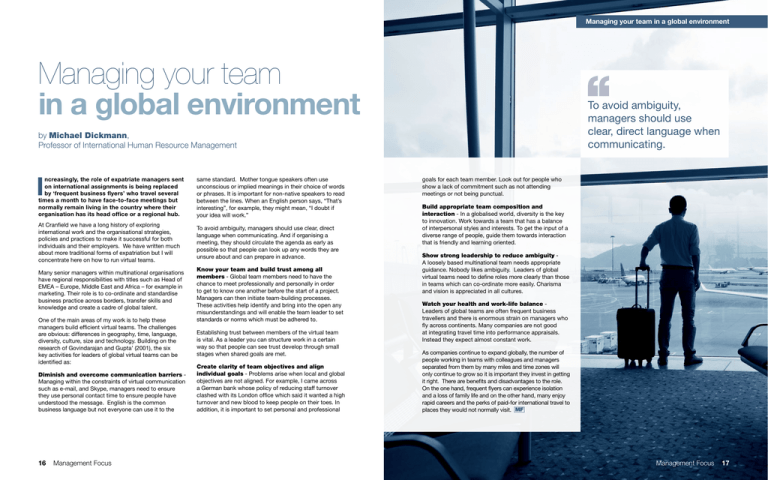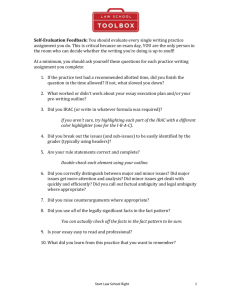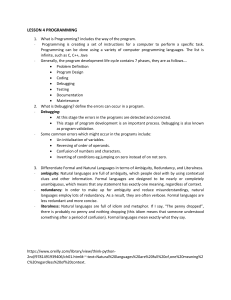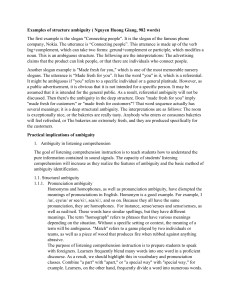Managing your team in a global environment I To avoid ambiguity,
advertisement

Managing your team in a global environment Managing your team in a global environment To avoid ambiguity, managers should use clear, direct language when communicating. by Michael Dickmann, Professor of International Human Resource Management I ncreasingly, the role of expatriate managers sent on international assignments is being replaced by ‘frequent business flyers’ who travel several times a month to have face-to-face meetings but normally remain living in the country where their organisation has its head office or a regional hub. same standard. Mother tongue speakers often use unconscious or implied meanings in their choice of words or phrases. It is important for non-native speakers to read between the lines. When an English person says, “That’s interesting”, for example, they might mean, “I doubt if your idea will work.” At Cranfield we have a long history of exploring international work and the organisational strategies, policies and practices to make it successful for both individuals and their employers. We have written much about more traditional forms of expatriation but I will concentrate here on how to run virtual teams. To avoid ambiguity, managers should use clear, direct language when communicating. And if organising a meeting, they should circulate the agenda as early as possible so that people can look up any words they are unsure about and can prepare in advance. Many senior managers within multinational organisations have regional responsibilities with titles such as Head of EMEA – Europe, Middle East and Africa – for example in marketing. Their role is to co-ordinate and standardise business practice across borders, transfer skills and knowledge and create a cadre of global talent. One of the main areas of my work is to help these managers build efficient virtual teams. The challenges are obvious: differences in geography, time, language, diversity, culture, size and technology. Building on the research of Govindarajan and Gupta’ (2001), the six key activities for leaders of global virtual teams can be identified as: Diminish and overcome communication barriers Managing within the constraints of virtual communication such as e-mail, and Skype, managers need to ensure they use personal contact time to ensure people have understood the message. English is the common business language but not everyone can use it to the 16 Management Focus Know your team and build trust among all members - Global team members need to have the chance to meet professionally and personally in order to get to know one another before the start of a project. Managers can then initiate team-building processes. These activities help identify and bring into the open any misunderstandings and will enable the team leader to set standards or norms which must be adhered to. Establishing trust between members of the virtual team is vital. As a leader you can structure work in a certain way so that people can see trust develop through small stages when shared goals are met. Create clarity of team objectives and align individual goals - Problems arise when local and global objectives are not aligned. For example, I came across a German bank whose policy of reducing staff turnover clashed with its London office which said it wanted a high turnover and new blood to keep people on their toes. In addition, it is important to set personal and professional goals for each team member. Look out for people who show a lack of commitment such as not attending meetings or not being punctual. Build appropriate team composition and interaction - In a globalised world, diversity is the key to innovation. Work towards a team that has a balance of interpersonal styles and interests. To get the input of a diverse range of people, guide them towards interaction that is friendly and learning oriented. Show strong leadership to reduce ambiguity - A loosely based multinational team needs appropriate guidance. Nobody likes ambiguity. Leaders of global virtual teams need to define roles more clearly than those in teams which can co-ordinate more easily. Charisma and vision is appreciated in all cultures. Watch your health and work-life balance - Leaders of global teams are often frequent business travellers and there is enormous strain on managers who fly across continents. Many companies are not good at integrating travel time into performance appraisals. Instead they expect almost constant work. As companies continue to expand globally, the number of people working in teams with colleagues and managers separated from them by many miles and time zones will only continue to grow so it is important they invest in getting it right. There are benefits and disadvantages to the role. On the one hand, frequent flyers can experience isolation and a loss of family life and on the other hand, many enjoy rapid careers and the perks of paid-for international travel to places they would not normally visit. MF Management Focus 17











